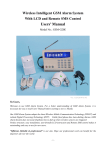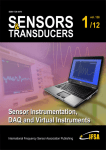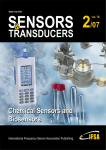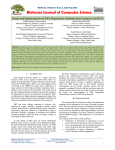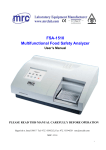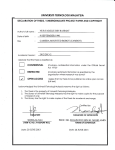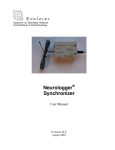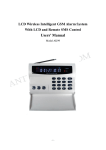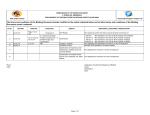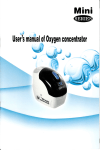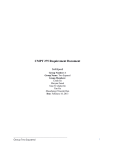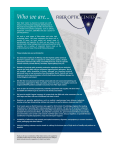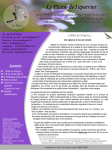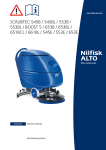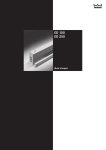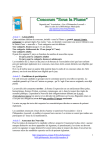Download Sensors & Transducers
Transcript
Copyright 2013 IFSA Publishing. All rights reserved. This journal and the individual contributions in it are protected under copyright by IFSA Publishing, and the following terms and conditions apply to their use: Photocopying: Single photocopies of single articles may be made for personal use as allowed by national copyright laws. Permission of the Publisher and payment of a fee is required for all other photocopying, including multiple or systematic copyright, copyright for advertising or promotional purposes, resale, and all forms of document delivery. Derivative Works: Subscribers may reproduce tables of contents or prepare list of articles including abstract for internal circulation within their institutions. Permission of the Publisher is required for resale or distribution outside the institution. Permission of the Publisher is required for all other derivative works, including compilations and translations. Authors' copies of Sensors & Transducers journal and articles published in it are for personal use only. Address permissions requests to: IFSA Publisher by e-mail: [email protected] Notice: No responsibility is assumed by the Publisher for any injury and/or damage to persons or property as a matter of products liability, negligence or otherwise, or from any use or operation of any methods, products, instructions or ideas contained in the material herein. Printed in the USA. Sensors & Transducers Volume 148, Issue 1 January 2013 www.sensorsportal.com ISSN 1726-5479 Editors-in-Chief: professor Sergey Y. Yurish, Tel.: +34 696067716, e-mail: [email protected] Editors for Western Europe Editor South America Meijer, Gerard C.M., Delft Univ. of Technology, The Netherlands Ferrari, Vittorio, Universitá di Brescia, Italy Costa-Felix, Rodrigo, Inmetro, Brazil Editors for Asia Editor for Eastern Europe Sachenko, Anatoly, Ternopil National Economic University, Ukraine Ohyama, Shinji, Tokyo Institute of Technology, Japan Zhengbing, Hu, Huazhong Univ. of Science and Technol., China Editor for Asia-Pacific Editors for North America Mukhopadhyay, Subhas, Massey University, New Zealand Katz, Evgeny, Clarkson University, USA Datskos, Panos G., Oak Ridge National Laboratory, USA Fabien, J. Josse, Marquette University, USA Editor for Africa Maki K.Habib, American University in Cairo, Egypt Editorial Board Abdul Rahim, Ruzairi, Universiti Teknologi, Malaysia Abramchuk, George, Measur. Tech. & Advanced Applications, Canada Ascoli, Giorgio, George Mason University, USA Atalay, Selcuk, Inonu University, Turkey Atghiaee, Ahmad, University of Tehran, Iran Augutis, Vygantas, Kaunas University of Technology, Lithuania Ayesh, Aladdin, De Montfort University, UK Baliga, Shankar, B., General Monitors, USA Basu, Sukumar, Jadavpur University, India Bouvet, Marcel, University of Burgundy, France Campanella, Luigi, University La Sapienza, Italy Carvalho, Vitor, Minho University, Portugal Changhai, Ru, Harbin Engineering University, China Chen, Wei, Hefei University of Technology, China Cheng-Ta, Chiang, National Chia-Yi University, Taiwan Chung, Wen-Yaw, Chung Yuan Christian University, Taiwan Cortes, Camilo A., Universidad Nacional de Colombia, Colombia D'Amico, Arnaldo, Università di Tor Vergata, Italy De Stefano, Luca, Institute for Microelectronics and Microsystem, Italy Ding, Jianning, Changzhou University, China Djordjevich, Alexandar, City University of Hong Kong, Hong Kong Donato, Nicola, University of Messina, Italy Dong, Feng, Tianjin University, China Erkmen, Aydan M., Middle East Technical University, Turkey Gaura, Elena, Coventry University, UK Gole, James, Georgia Institute of Technology, USA Gong, Hao, National University of Singapore, Singapore Gonzalez de la Rosa, Juan Jose, University of Cadiz, Spain Guillet, Bruno, University of Caen, France Hadjiloucas, Sillas, The University of Reading, UK Hui, David, University of New Orleans, USA Jaffrezic-Renault, Nicole, Claude Bernard University Lyon 1, France Jamil, Mohammad, Qatar University, Qatar Kaniusas, Eugenijus, Vienna University of Technology, Austria Kim, Min Young, Kyungpook National University, Korea Kumar, Arun, University of Delaware, USA Lay-Ekuakille, Aime, University of Lecce, Italy Lin, Paul, Cleveland State University, USA Liu, Aihua, Chinese Academy of Sciences, China Mansor, Muhammad Naufal, University Malaysia Perlis, Malaysia Marquez, Alfredo, Centro de Investigacion en Materiales Avanzados, Mexico Mishra, Vivekanand, National Institute of Technology, India Moghavvemi, Mahmoud, University of Malaya, Malaysia Morello, Rosario, University "Mediterranea" of Reggio Calabria, Italy Mulla, Imtiaz Sirajuddin, National Chemical Laboratory, Pune, India Nabok, Aleksey, Sheffield Hallam University, UK Neshkova, Milka, Bulgarian Academy of Sciences, Bulgaria Passaro, Vittorio M. N., Politecnico di Bari, Italy Penza, Michele, ENEA, Italy Pereira, Jose Miguel, Instituto Politecnico de Setebal, Portugal Pogacnik, Lea, University of Ljubljana, Slovenia Pullini, Daniele, Centro Ricerche FIAT, Italy Reig, Candid, University of Valencia, Spain Restivo, Maria Teresa, University of Porto, Portugal Rodríguez Martínez, Angel, Universidad Politécnica de Cataluña, Spain Sadana, Ajit, University of Mississippi, USA Sadeghian Marnani, Hamed, TU Delft, The Netherlands Sapozhnikova, Ksenia, D. I. Mendeleyev Institute for Metrology, Russia Singhal, Subodh Kumar, National Physical Laboratory, India Shah, Kriyang, La Trobe University, Australia Shi, Wendian, California Institute of Technology, USA Shmaliy, Yuriy, Guanajuato University, Mexico Song, Xu, An Yang Normal University, China Srivastava, Arvind K., LightField, Corp, USA Stefanescu, Dan Mihai, Romanian Measurement Society, Romania Sumriddetchkajorn, Sarun, Nat. Electr. & Comp. Tech. Center, Thailand Sun, Zhiqiang, Central South University, China Sysoev, Victor, Saratov State Technical University, Russia Thirunavukkarasu, I., Manipal University Karnataka, India Vazquez, Carmen, Universidad Carlos III Madrid, Spain Wang, Jiangping, Xian Shiyou University, China Xue, Ning, Agiltron, Inc., USA Yang, Dongfang, National Research Council, Canada Yang, Shuang-Hua, Loughborough University, UK Yaping Dan, Harvard University, USA Zakaria, Zulkarnay, University Malaysia Perlis, Malaysia Zhang, Weiping, Shanghai Jiao Tong University, China Zhang, Wenming, Shanghai Jiao Tong University, China Sensors & Transducers Journal (ISSN 1726-5479) is a peer review international journal published monthly online by International Frequency Sensor Association (IFSA). Available in both: print and electronic (printable pdf) formats. Copyright © 2013 by International Frequency Sensor Association. All rights reserved. Sensors & Transducers Journal Contents Volume 148 Issue 1 January 2013 www.sensorsportal.com ISSN 1726-5479 Research Articles Low Value Capacitance Measurements for Capacitive Sensors – A Review Prabhu Ramanathan, Sudha Ramasamy, Prateek Jain, Hardik Nagrecha, Saurav Paul, P.Arulmozhivarman, Rao Tatavarti ........................................................................................... 1 Microelectromechanical System (MEMS) Switches for Radio Frequency Applications - A Review Ashish Kumar Sharma, Navneet Gupta.................................................................................... 11 Measurement of Transient Surface Temperature of Conductive Solid Using Thermocouples with Different Junctions Zhiqiang Sun, Yu Chen, Xing Chen .......................................................................................... 22 Optical Force Sensor for the DEXMART Hand Twisted String Actuation System Gianluca Palli and Salvatore Pirozzi ......................................................................................... 28 Ultrasonic Tomography Imaging for Liquid-Gas Flow Measurement Muhammad Jaysuman Pusppanathan, Nor Muzakkir Nor Ayob, Fazlul Rahman Yunus, Khairul Hamimah Abas, Herlina Abdul Rahim, Leo Pei Ling, Ruzairi Abdul Rahim, Fatin Aliah Phang, Mohd Hafiz Fazalul Rahiman, Zulkarnay Zakaria ...................................... 33 Development of Ethernet Based Remote Monitoring and Controlling of MST Radar Transmitters using ARM Cortex Microcontroller Lakshmi Narayana Roshanna, Nagabhushan Raju Konduru, Rajendra Prasad Thommundru, Chandrasekhar Reddy Devanna, Chaitanya Pavan Kanchisamudram 40 A Portable Spectrophotometer for Water Quality Analysis Xiaomin Zhang, Yanjun Fang, Youquan Zhao.......................................................................... 47 MATLAB Graphical User Interface based Fuzzy Logic Controllers for Liquid Level Control System Immanuel J., Parvathi C. S., L. Shrimanth Sudheer and P. Bhaskar ....................................... 52 Method and Device for Image Coding & Transferring Based on Residue Number System Su Jun, Vasyl Yatskiv................................................................................................................ 60 Estimation of Emissivity with the Help of an Infrared Camera B. Chakraborty and B. K. Sinha ................................................................................................ 66 Simple and Robust Multipoint Data Acquisition Bus Built on Top of the Standard RS 232 Interface Alexey Pavluchenko, Alexander Kukla, Sergey Lozovoy. ........................................................ 72 Optimizing Micro-scale Thermoelectric Model using Finite Element Method Divya Jatain, Ajay Agarwal, Manoj Kumar ................................................................................ 83 A Portable Colloidal Gold Strip Sensor for Clenbuterol and Ractopamine using Image Processing Technology Yi Guo, Feng He, Youquan Zhao, Yanjun Fang, Zhuge Xi....................................................... 89 Multicomponent Liquids’ Research Petro Stolyarchuk, Maryna Mikhalieva, Vasyl Yatsuk, Yevhen Pokhodylo, Olena Basalkevych. .................................................................................................................. 95 Authors are encouraged to submit article in MS Word (doc) and Acrobat (pdf) formats by e-mail: [email protected]. Please visit journal’s webpage with preparation instructions: http://www.sensorsportal.com/HTML/DIGEST/Submition.htm International Frequency Sensor Association (IFSA). Sensors & Transducers, Vol. 148, Issue 1, January 2013, pp. 40-46 Sensors & Transducers ISSN 1726-5479 © 2013 by IFSA http://www.sensorsportal.com Development of Ethernet Based Remote Monitoring and Controlling of MST Radar Transmitters using ARM Cortex Microcontroller 1* Lakshmi Narayana ROSHANNA, 1 Nagabhushan Raju KONDURU, 2 Rajendra Prasad THOMMUNDRU, 3 Chandrasekhar Reddy DEVANNA, 4 Chaitanya Pavan KANCHISAMUDRAM 1 Department of Instrumentation, Sri Krishnadevaraya University, Anantapur, 515003, India Tel.: 08554 - 255744 2 National Atmospheric Research Laboratory (NARL), Gadanki, 517112, India Tel.: +91 858 527 2003, fax: +91 858 527 2018 3, 4 Megabyte Technologies, Bangalore Tel.: +91 974 014 3321 E-mail: [email protected], [email protected], [email protected], [email protected], [email protected] Received: 7 November 2012 /Accepted: 24 January 2013 /Published: 31 January 2013 Abstract: The recently emerging Web Services technology has provided a new and excellent solution to Industrial Automation in online control and remote monitoring. In this paper, a Web Service Based Remote Monitoring & Controlling of Radar Transmitters for safety management (WMCT) developed for MST Radar is described. It achieved the MST radar transmitters’ remote supervisory, data logging and controlling activities. The system is developed using an ARM Cortex M3 processor to monitor and control the 32 triode-based transmitters of the 53-MHz Radar. The system controls transmitters via the internet using an Ethernet client server and store health status in the Database for radar performance analysis. The system enables scientists to operate and control the radar transmitters from a remote client machine Webpage. Copyright © 2013 IFSA. Keywords: ARM cortex-M3 Processor, MST radar, ASP, Net C#. 1. Introduction MST Radar located near Gadanki (13.5°N, 79.2°E) India is a prime instrument for atmospheric science research, the fig. 1 is the bird’s eye view of the radar antenna array and transmitter control rooms. Scientific research is being performed with Indian MST Radar for the past two decades, by constantly 40 upgrading the Radar with state of the art technological features. It is a very powerful remote sensing tool for studying the Earth’s atmosphere from 3.6 km up to ionized F layer regions. During two decades of its operations from 1991, more than 300 publications of international repute were published and it is being extensively operated round the clock for scientific research in the Ionosphere, Mesosphere, lower Stratosphere and Troposphere regions. Sensors & Transducers, Vol. 148, Issue 1, January 2013, pp. 40-46 LM3S9B96 microcontroller to control the radar transmitters through remote Embedded Web based Real Time Application. The microcontroller, Ethernet MAC, and PHY are incorporated on a single chip, thereby eliminating more external components. This enables the MAC and PHY to be matched and reduces the overall pin count and chip footprint. It can also lower power consumption, especially if power-down modes are implemented. Real-time performance of radar is improved with this activity utilizing industrial Ethernet technology and fast 10 bit ADC. Fig. 1. Photograph of MST radar antenna array, transmitters rooms bird’s eye view. 2. Experimental Setup The MST Radar consists of 32 transmitters powering 1024-element phased antenna array. Each transmitter provides an RF gain of 81 dB with four stages of amplifiers; solid-state amplifier followed by triode based amplifiers namely pre-driver, driver, and high power amplifiers. Remote supervisory control and comprehensive safety interlock is built-in the system to protect expensive devices. The remote system senses TX critical parameters like anode voltages, heater currents, temperature and airflow etc for all 32 transmitters. This system receives input from the sensors placed in the amplifier cavities and monitors a total of 12 safety parameters. This unit logic circuit process sensor data for abnormal voltage, temperature and current deviations, and switches-off the Transmitter subsystems incase of any mall functions, with the help of Control unit. The Fig. 2 is the hardware interface of radar transmitters and interlock control. Fig. 3 presents total Setup of transmitter’s remote monitoring and control ported into ARM Cortex-M3 processor with Ethernet connectivity to remote computer. The conventional hardware functioning logic is incorporated in the Texas Instruments device LM3S9B96. This ARM Cortex-M3 processor is programmed to interface with the remote console computer WEB page, to monitor the health condition of the transmitters, and to produce control actions to ensure transmitter safety. The user selection buttons and TX sensor parameters have been interfaced to the ARM Cortex-M3 processor through digital I/O lines to control the transmitter parameters. The analog to digital converters (ADC) read the sensors outputs in the transmitters; the digital data are framed in packets and sent to a web server. The remote webpage communicates to a client transmitter in the network with IP to monitor, log data and control through internet. ARM Cortex-M3 MC RADAR Transmit ter Fig. 2. Photograph of hardware interface and radar transmitters. This interlock control unit ensures the protection of the expensive devices from any failure in the system. The transmitters can be operated in auto mode (remotely) as well as in the manual mode (by using front panel switches). In the auto mode, each transmitter is made to operate in a predefined mode. The original TTL ICs based 15 board system was replaced by low-cost Xilinx XC9572C10pc84 CPLD and later is upgraded with ARM Cortex-M3 Fig. 3. WMCT system setup. 41 Sensors & Transducers, Vol. 148, Issue 1, January 2013, pp. 40-46 Keil-4 (IDE) software targeted onto ARM CortexM3 based LM3S9B96 device programs the monitoring and controlling functionalities. This system connects the Triode based transmitters through internet to control and monitor the health of four RF amplifier stages. Thus ‘Design and Development of a web-based Real-Time Radar Transmitter remote control system for safety management’ allow scientists to operate and control the transmitters from remote client with the help of web servers using a web page. 3. Hardware Description The Hardware included radar transmitter is microcontroller LM3S9B96 pin diagram is shown in Fig. 4, ADC, DAC, RTC, 5 V and 3.3 V power supply, RJ45, relays circuit to control the transmitter. The microcontroller is the brain of the web based remote supervisory and control system. J1 connector is a JTAG port in Fig. 5 is used to dump program and helps in debugging the software functionality. The GPIO module is composed of nine physical GPIO blocks, each corresponding to an individual GPIO port (Port A, Port B, Port C, Port D, Port E, Port F, Port G, Port H, Port J). The GPIO module supports up to 65 programmable input/output pins; we are using 8 GPIOs to control the transmitter relays. The Fig. 6 is the hardware connectivity of relays with GPIOs. The IC ULN 2803 is used to relay controlling with sufficient current drive. Two 10-bit Analog-to-Digital Converters (ADC) with 16 analog input channels and sample rate of one million samples/second are used to digitize 14 sensor parameters for reading the sensor outputs (transmitter parameters). In the Fig. 7 Max-232 is a serial line driver to establish the communication between microcontroller and PC. In Fig. 8 the SST’s 25 series Serial Flash family is a four-wire, SPI-compatible interface that allows for a low pin-count package which occupies less board space and ultimately lowers total system costs. Fig. 4. LM3S9B96 MCU schematic diagram. 42 Sensors & Transducers, Vol. 148, Issue 1, January 2013, pp. 40-46 Fig. 5. Jtag interface schematic diagram. Fig. 6. Relay driver schematic diagram. Fig. 7. Max-232 Line driver schematic diagram. 43 Sensors & Transducers, Vol. 148, Issue 1, January 2013, pp. 40-46 Fig. 8. Memory interface schematic diagram. The Stellaris® Ethernet Controller consists of a fully integrated media access controller (MAC) and network physical (PHY) interface. The Ethernet Controller conforms to IEEE 802.3 specifications and fully supports 10BASE-T and 100BASE-TX standards. In Fig. 9 the schematic of RJ45 Ethernet connectivity is shown. This Ethernet feature is used to communicate computer through the network. Fig. 9. Ethernet schematic diagram. 44 4. Software Implementation To provide the flexibility and to reduce complexity, modularization programming method has been implemented. Modularizing the whole software resulted in flexibility of designing, testing, debugging and maintenance. The following two points are considered in program, first one is to distribute system resources by functionality i.e. ROM, RAM, interrupt sources and so on, second point is enhancing its universality and anti-jamming ability. Keil cross compiler and embedded C language combination are used for application program writing. It has a real-time multitasked kernel and offers TCP/IP programming of SOCKET grade and support various kinds of network protocols (such as HTTP, FTP, SMTP, PPP). With the development of network technology TCP/IP protocol has been written into the embedded system. As a result, embedded system became an embedded web system. The controller of embedded system turns into a miniature network server. By this, the seamless link of bottom equipment with internet becomes true and the remote monitoring is indeed realized. Installation of TCP/IP protocol in LM3S9B96 controller realizes Internet connectivity to the equipment. The web server software has been developed by Microsoft ASP.NET and C# tools. The Web page GUI (Graphical User Interface) which runs on a web server is implemented in hypertext markup language (HTML). The background controls and sockets have been implemented using C# programming in ASP.NET framework. This server software allows communicating remote clients from any web Sensors & Transducers, Vol. 148, Issue 1, January 2013, pp. 40-46 browsing compatible operating system to interact with our experimental test-bed. The transmitters’ sensor values for every 10 minutes are logged in a database designed using SQL Server2008. The web server stores the transmitter health status in database continuously. This recorded data can be viewed in the grid view format for analysis. RF ON/OFF and control ON/OFF button the respective command/data is sent by the client browser to the server through the protocol layer of the TCP/IP stack. Then the server logically handles the data and sends to the microcontroller. The web server load transmitter current status automatically in few seconds refresh rate of a web page. ARM Cortex-M3 microcontroller will take the appropriate actions. 5. Results and Discussions The design and implementation of ARM CortexM3 processor based Interlock and fault monitoring plug–in is thus carried out due to its advantages over high density code size, cost and power requirements. The combination of complexity and speed is finding ready applications for ARM Cortex-M3 systems in digital processing and particularly in those application areas requiring sophisticated high speed digital processing. The following are the measurements of parameters in radar Transmitter. Check the Transmitter radiation to measure TX power output by giving RF input. Transmitter output power at 60 dB coupler = V (pk-pk) = 3 V Power=Vrms2/R Power=(V(pk-pk)2/8R)=[ V(pk-pk)2/800]106 = = 22.5 kWatt Power=10log(power)/10-3 =73.5 dBm In Fig. 10 the web page contains an RF ON/OFF button used for switching on the RF power circuitry on the transmitter. The health status of each parameter and voltage levels are mentioned in Tables 1, 2 and 3. Health status is good or bad is indicated as a colorful bubble. The RED is indicated as fault/bad condition of the corresponding parameter and GREEN indicates good condition. When click on the Table 1. Fan sense signals. Amplifier PDR DR HPA OFF 4.67 4.82 4.82 ON 0 0 0 Table 2. Heater current Sense Voltages. Amplifier OFF PDR DR HPA 0 0.3 0 HALF HEATER POWER (1st 3min) 2.4 2.5 2.6 FULL HEATER POWER (after 3min) 3.4 3.6 3.13 Table 3. Anode supply sense Monitor Voltages. Amplifier PDR DR HPA Anode supply OFF 2.7 1.5 1.7 Anode supply ON 3.1 2.4 3.06 Fig. 10. Screen shot of webpage Transmitter parameters health status and controls. 45 Sensors & Transducers, Vol. 148, Issue 1, January 2013, pp. 40-46 6. Conclusion References A WMCT is proposed in this paper. It is intended to support the capabilities of the remote supervisory and controlling system based on web services technology for embedded devices is designed and implemented. The system adopts Browser/Server mode and realizes the interconnection of the embedded devices like ARM Cortex-M3 Processor target board. Therefore, remote users can access, control and manage the embedded devices [ARM Cortex-M3 processor through the MST radar transmitter] using a standard web browser over the internet. It has advantages of small size, data logger, system maintenance, longer work time and stable performance. It is applicable to a variety of fields like industrial control, industrial automation, medical, instrument etc. [1]. User’s Manual, Control and Interlock Units, National Atmospheric Research Laboratory, 1996. [3]. Design of Control and Interlocking System for a Typical Radar Transmitter, Nagabhushan Raju KONDURU, Department of Instrumentation, Sri Krishnadevaraya University, Anantapur – 515 003. India, Accepted: 24 July 2010 /Published: 31 July 2010. [4]. Nagabhushan Raju K, Lakshmi Narayana R, Rajendra Prasad T, Chandrasekhar Reddy D, An Embedded Web based Real Time Application for Remote Monitoring & Controlling of MST RADAR Transmitters, Sensors & Transducers, Vol. 136, Issue 1, January 2012, pp. 96-104. [5]. Texas Instruments Microcontrollers (TI-MCU) datasheet, [Online]: http://www.ti.com/ds/symlink/ lm3s9b96.pdf [6]. The website of the Keil compiler and IDE [online]. http://www.keil.com/arm/mdk.asp/ [7]. Microsoft website [Online], http://www.microsoft. com [8]. Murach's ASP.NET 4 Web Programming with C# 2010 by Joel Murach and Anne Boehm. [9]. Programming Microsoft SQL Server 2008 (PRODeveloper), Leonard Lobel, Andrew J. Brust and Stephen Forte. Acknowledgement The authors express profound gratitude and thanks to the Director, National Atmospheric Research Laboratory at Gadanki for providing facilities, encouragement and guidance during the research period. ___________________ 2013 Copyright ©, International Frequency Sensor Association (IFSA). All rights reserved. (http://www.sensorsportal.com) 46 Aims and Scope Sensors & Transducers is a peer reviewed international, interdisciplinary journal that provides an advanced forum for the science and technology of physical, chemical sensors and biosensors. It publishes original research articles, timely state-of-the-art reviews and application specific articles with the following devices areas: Physical, chemical and biosensors; Digital, frequency, period, duty-cycle, time interval, PWM, pulse number output sensors and transducers; Theory, principles, effects, design, standardization and modeling; Smart sensors and systems; Sensor instrumentation; Virtual instruments; Sensors interfaces, buses and networks; Signal processing and interfacing; Frequency (period, duty-cycle)-to-code converters, ADC; Technologies and materials; Nanosensors; Microsystems; Applications. Further information on this journal is available from the Publisher's web site: http://www.sensorsportal.com/HTML/DIGEST/Submission.htm Subscriptions An annual subscription includes 12 regular issues and some special issues. Annual subscription rates for 2013 are the following: Electronic version (in printable pdf format): 400.00 EUR Printed with b/w illustrations: 640.00 EUR Printed full color version: 760.00 EUR 40 % discount is available for IFSA Members. Prices include shipping costs by mail. Further information about subscription is available through IFSA Publishing's web site: http://www.sensorsportal.com/HTML/DIGEST/Journal_Subscription.htm Advertising Information If you are interested in advertising or other commercial opportunities please e-mail [email protected] and your enquiry will be passed to the correct person who will respond to you within 24 hours. Please download also our Media Planner 2013: http://www.sensorsportal.com/DOWNLOADS/Media_Planner_2013.pdf Books for Review Publications should be sent to the IFSA Publishing Office: Ronda de Ramon Otero Pedrayo, 42C, 1-5, 08860, Castelldefels, Barcelona, Spain. Abstracting Services This journal is cited, indexed and abstracted by Chemical Abstracts, EBSCO Publishing, IndexCopernicus Journals Master List, ProQuest Science Journals, CAS Source Index (CASSI), Ulrich's Periodicals Directory, Scirus, Google Scholar, etc. Since 2011 Sensors & Transducers journal is covered and indexed (including a Scopus, Embase, Engineering Village and Reaxys) in Elsevier products. Instructions for Authors Please visit the journal web page http://www.sensorsportal.com/HTML/DIGEST/Submission.htm Authors must follow the instructions very carefully when submitting their manuscripts. Manuscript must be send electronically in both: MS Word 2003 for Windows (doc) and Acrobat (pdf) formats by e-mail: [email protected]

















